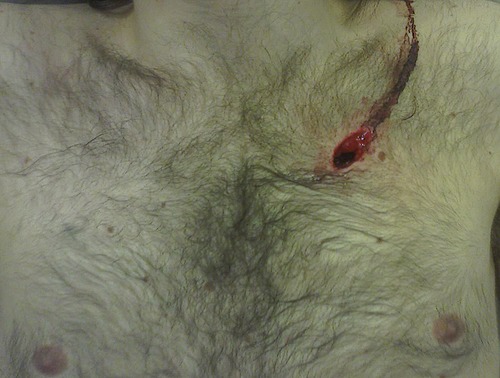CASE 15
Relevant information
▪ Aircraft: Off-line. Rapid response road vehicle available
▪ Ground resources: One land ambulance. Large number of Police Service personnel
▪ Retrieval options: General hospital 15 minutes by road. Major trauma hospital 25 minutes by road
▪ Other: Ambient conditions Heavy rain 9°C (48°F)
Questions
15.1 What is your pre-hospital plan prior to arrival?
On arrival, you are met by a senior police officer and escorted through into the hotel entrance. Police are attempting to remove a large crowd from the main bar. A number of patrons have blood-stained clothing. You are the focus of verbal abuse as you pass them.
You are directed up a set of stairs to where the patient has been found slumped in a toilet cubicle. As you enter the crowded corridor outside the toilet, an Ambulance Service paramedic appears. She informs you that on her arrival (less than 5 minutes ago), the patient ‘appeared drunk’, was combative and refusing assistance. At that time, she had been unable to further assess him.
He has since become ‘unresponsive’. She has placed a 16-gauge intravenous cannulae in his antecubital fossa and checked his blood glucose level (within normal limits). She is now unable to feel a radial pulse. From the cubicle door, you can see he is taking occasional gasping breaths.
15.2 Outline your initial management.
The police have rapidly cleared the upper floor of the hotel. The toilet is being cordoned off and police guard the door. The patient has been removed from the cubicle to a large floor area and his clothes have been cut off. Non-invasive monitoring is in place. A rapid assessment reveals the following clinical information:
• A – Clear.
• B – Apnoeic. Receiving assisted ventilation with bag valve mask device.
• C – Pale. Cold. No central pulse. BP and SaO2 machines giving error message. Monitor showing sinus bradycardia (55 beats per minute).
• D – Unresponsive to central stimulus.
• E – See picture over the page.
 |
15.3 How will you proceed? Describe the procedure.
A resuscitative thoracotomy reveals a pericardial tamponade. On release, there is spontaneous return of both myocardial contraction and circulation. An apparent right ventricular wound is bleeding minimally. The patient is intubated and ventilated and en route to the ambulance. Contact is made with the receiving trauma hospital and your tasking agency.
Clinical information:
• ETCO2 35 mmHg (4.5 kPa).
• BP 105/64 mmHg.
• P 105.
En route, you notice a return of spontaneous ventilatory effort and occasional coughing. You also notice a moderate amount of blood flowing from the pleural incisions.
15.4 What will you do now?
< div class='tao-gold-member'>
Only gold members can continue reading. Log In or Register to continue
Stay updated, free articles. Join our Telegram channel

Full access? Get Clinical Tree








